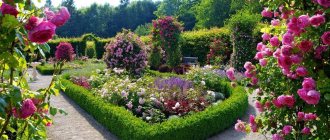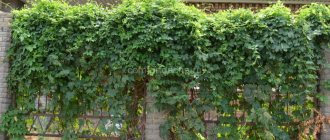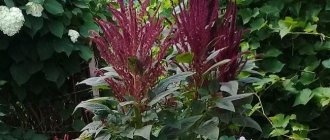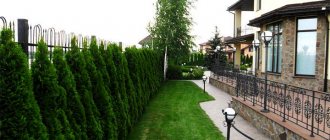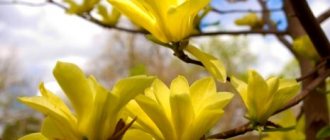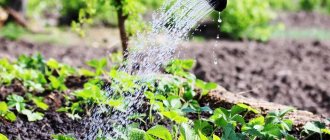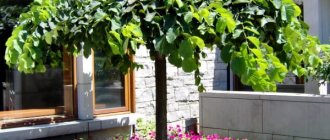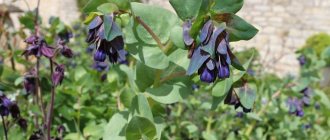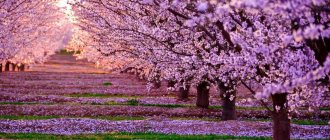A beautiful flower garden along the fence helps to ennoble a narrow strip of land, which owners of private households often ignore. Green spaces enliven the landscape design along the fence, create cozy decorative corners, and protect the area from street noise and prying glances from neighbors. We will tell you in this article how to choose the right plants and create a flowerbed near the fence that will harmoniously fit into a single ensemble of a summer cottage.
Where to begin?
Experts advise planning and placing trees and shrubs along the fence and paths immediately, simultaneously with planning a suburban building. An integrated approach to organizing and filling space will allow the summer cottage site to acquire a lived-in appearance by the end of construction work, be filled with greenery and look like a real kingdom of nature.
Site plan with location of shrubs
Before starting landscaping work, inspect the area, familiarize yourself with its advantages and pay attention to its disadvantages, evaluate the possibilities and conditions for planting. This is very important for choosing varieties and varieties of trees and shrubs.
When arranging a suburban area, in order to maintain the harmony of all components and get a complete space, it is better to pay attention and be guided by the recommendations developed by specialists. Before deciding which plantings will grow near the fence, which bushes inside the territory, you need to pay attention to the suburban space and get answers to the following questions:
1. Decide on the purpose of the bushes and trees used for landscaping the site. Figure out what your goal is when planting: to close an ugly fence or to decorate a lovely structure. Choose what main function the plants will serve: to camouflage the fence or to harmoniously coexist with it.
Masking a fence with bushes
2. Determine for yourself what part of the space falls under the control of trees and shrubs, and how much free space it costs to leave. Do not overload the area. Excessive loading of trees and shrubs along the fence, especially tall plants, will visually reduce the area and make it oversaturated.
Shrubs along the paths should not overload the space
3. Determine which side of the fence is available for planting: brightly lit by the sun or constantly in the shade. When planting trees, focus on the shade cast by the fence and plant plants that grow well in those shady conditions.
Barberry bushes tolerate shade well
4. What is the soil like in the area of future planting? In order for a plant to truly reveal its decorative properties, it must grow in comfortable conditions.
5. How much subsequent care is expected for the plant. Is it possible to provide constant attention to the capricious flora, to provide pruning and shaping of trees and shrubs that need it?
Hedges need regular maintenance
There are two options for the formation of vegetation on a personal plot:
1. Landscape planning does not require special human participation. This method of forming a territory is especially suitable for areas located on uneven terrain. In this case, due to the natural difference in levels, the plants look beautiful and together form interesting compositions.
Free landscape planning of the site
2. Geometric layout involves maintaining certain distances between bushes and trees and maintaining strict geometric shapes. Most often, in this case, rows of densely planted trees are created. There is empty space between the rows and lonely vertical plants in the middle of the plot.
Strict geometric layout of the site
Gardening methods
To make the design of a small plot created with your own hands pleasing, you should follow several basic landscaping rules:
- First of all, it is worth considering the lightening requirements of certain trees, shrubs and flowers.
- The planting height should increase in the direction from south to north. The shortest specimens should be planted on the south side, and tall trees, such as pears and apple trees, on the northeast or north side.
- If the soil on the site is poor, then it is worth bringing in fertile soil. Alas, manure and compost will not immediately correct the situation and saturate the soil with nutrients.
- The color scheme should be thought out in advance. Correctly chosen shades will visually enlarge a small area.
- Don't chase diversity. An abundance of different shades in a garden plot is not always good. It is worth choosing one color scheme and placing its variations in different corners of the site. This step will allow you to achieve harmony.
Water features
Landscaping a small area is a complex process. When creating certain compositions, the basic rules and requirements should be taken into account. In this case, ponds and small reservoirs can perform not only practical functions, but also decorative ones.
The water can be used for irrigation. If desired, you can create small lakes for aesthetic purposes. If you decide to create a pond with your own hands, then you should take care in advance not only of building materials, but also of what plants and animals will live in it.
In addition, special equipment may be required to maintain such structures. As a water structure on the site you can build:
- water mill;
- fountain;
- waterfall or cascade;
- circulating stream.
Flowers and plants
Growing any plants near your home requires constant attention and a lot of time. In addition, there may be some financial costs involved. However, it is plants and flowers that allow you to fill your landscape design with bright colors.
If you wish, you can plant a small flower garden. At the same time, you should choose one color scheme.
Today you can purchase seeds of almost any ornamental plant that will allow you to decorate the area around your house. When arranging a summer cottage, you can use classic plants, or you can create an alpine slide. The choice largely depends on the style of the overall design.
What plants should I plant near the fence?
When choosing trees and shrubs along the fence and paths, pay attention to the fence itself, its appearance and the quality of the materials used. To choose plants that will be located in close proximity to the fence, you need to start from its characteristics:
Rabitz
The chain-link refers to fragile structures. You cannot put a powerful bush or climbing vine on top of an unsecured fence; they will certainly destroy the fence. But on the other hand, a transparent fence on a site is considered an undesirable species.
Chain-link fence on the site
The private life of a family living in a country house should not be in the public domain and needs some kind of cover. In this case, bushes that are capable of supporting themselves and creating an obstacle for prying eyes are suitable for planting: lilac, serviceberry, thuja.
Lilac bushes cover an unsightly chain-link fence
Bushes of barberry, chokeberry or hawthorn planted near the fence look good. Plants are planted at a distance of up to a meter from the fence in a hole, planting depth from 0.5 m.
Hawthorn bushes in the design of a fence
Wooden fence
You can plant any shrubs and trees near a wooden fence. This is a great place for fruit seedlings and climbing shrubs such as hops. The only limitation is the need for constant maintenance and the difficulties that arise with painting and maintaining the wooden fence.
Climbing shrubs go well with a wooden fence
Corrugated fence
There is an opinion that metal corrugated sheets are a rather unsafe structure for delicate plants. During a hot day, it heats up to high temperatures, and not all shrubs and trees can withstand such a hot neighborhood. But this opinion is disputed by the plants themselves. Lilacs grow well near the corrugated sheets, jasmine takes root, and raspberries feel confident. Its surface is easily entwined with vines.
Jasmine bushes can be planted next to a corrugated fence
Lianas
If your fence is made of chain-link mesh or other cellular material, climbing plants will be an excellent option for decorating the front side of the area. You can plant a new annual vine every year: morning glory, climbing varieties of nasturtium, sweet peas, fire beans, climbing kobe, dolichos, echinocystis lobes, quamoclitis lobes, winged thunbergia, climbing asarina, etc.
- The best flowering annual vines for the garden (25 photos)
These annual climbing plants are perfect for your garden!
Plant decorative foliage or flower crops at the foot of the vines. An alternative is to sow the remaining strip of land between the “climbing” fence and the road with lawn grass.
A durable fence can be decorated with perennial vines: ivy, tree pliers, virgin grapes, hops, actinidia, Chinese lemongrass, campsis, climbing roses, clematis, wisteria, honeysuckle honeysuckle, fluffy calistegia, petiole hydrangea, etc.
- Perennial vines for sunny and semi-shaded gardens
7 flowering vines for a sunny garden - with tables, photos and descriptions.
To make perennial vines look decorative, you will need not only to water and feed them, but also to trim them regularly - many of them turn into insidious invaders over time.
Shrubs along the fence
When choosing shrubs and trees for a suburban area, you can create not only luxurious greenery. Consider planting environmentally friendly and healthy fruit plants, which will be an additional source of microelements and vitamins. Pay attention to trees and shrubs that require little care and grow easily in your area.
A raspberry hedge is not only beautiful, but also useful
A beautiful solution is to create a fence from neighbors in the form of a hedge. With good care, the bushes form a solid wall, which it is advisable to trim periodically and at the same time you can give it an interesting shape. It is assumed that over time the bush will grow to a sufficient height, close its branches and look like a living fence. The only obstacle is the desire of the bushes to expand their habitat. In this case, the bushes must be constantly cut out and not allowed to conquer the entire suburban area.
You can independently adjust the height of the fence
You can use one type of shrub. By planting plants of different heights and colors, you will get a picturesque wall that will have a unique look twice a year: during the flowering period and in autumn. The abundance of colors will fill your country space with unique beauty.
Shrubs along the paths of different colors
Thuja, lilac, hydrangea and spirea are suitable for hedges. When choosing plants, note that some of them do not like to be around. So, for example, barberry and derain do not coexist well with each other.
Fluffy hydrangea bushes along the path
A good idea at first glance to plant shrubs with berries suitable for food near the fence does not always later seem successful. Fruiting plants quickly take root and begin to take over the nearby space, while the berries remain small and sour. When choosing a site near the fence for fruit bushes, such as currants, raspberries, and blackberries, you must constantly take measures to limit the possibility of their growth.
Trimming bushes along the fence
To do this, it is better to provide a lawn immediately behind the allocated area. Caring for shrubs involves tying up and trimming old branches. Plants also need weeding and weed control near the root. This must be done once a month.
Features of landing from the street
It has already been noted that it is better not to plant particularly valuable plants along the outside of fences; this can provoke their theft or damage, will require significant costs for organizing surveillance, and, in general, will significantly affect the comfort of living. It’s better to make do with unpretentious trees:
- poplar;
- maple;
- birch;
- Rowan.
The same hardy shrubs are also suitable:
- lilac;
- barberry;
- acacia (caragana).
The effect of the fence on the microclimate remains the same as on the territory of the site; we will not talk about it separately.
At the same time, one must remember about the growth of plantings over the years and take into account the location of power lines and other communications. Otherwise, there is a danger that utility services will independently solve the problem by sawing your trees, which will in no way make them decorative.
It is also necessary to take into account the location of sidewalks and possible interference with passing traffic, as this can also cause unpleasant interest on the part of the relevant services.
Shrubs along the paths
Decorating paths with a living ribbon of plants looks very beautiful and decorates the area. It is not necessary to create a continuous strip of low bushes. This planting will require special attention and care. It is enough to create small thickets of bushes around the paths, such as boxwood in the southern regions, and low thuja. At the corners of the path you can experiment, stacking slides of stones or one large boulder, placing creeping juniper bushes nearby.
Various types of bushes along the path
When planting plants, it is recommended to adhere to the following standards:
1. Trees should be located as far away from the path as possible, up to 1.5 m. Otherwise, their roots may disrupt the integrity of the coating, and the crown may interfere with the movement of people.
2. Shrubs are planted at a distance of up to one meter.
Spacing between shrubs in a hedge
3. It is advisable to arrange shrubs and trees in increasing height from south to north. In this case, the plants will not block each other from the sun.
Rules for planting trees and shrubs along fences and paths
When landscaping, the main thing is to correctly form all the plants and link them into a single whole. In this case, all vegetation will be in the human field of vision. All the colorful variety will be available for viewing and aesthetic pleasure.
Scheme for planting shrubs along the fence
In the spring, you will receive a real fairy tale of flowers, petals and young greenery, which can be combined into a single fresh composition across the site. And the sight of the autumn colorful palette, consisting of all known shades of green, brown, yellow, red and orange, will blow your mind. To do this, it is important that the following conditions are met:
1. The farther the plants are located from the path, the taller they should be.
2. Nearby trees and shrubs should not have tall forms that block the entire view.
3. Vegetation should not be the same in color and height, unless this should be a creative decision of the designer.
4. The diverse flora looks more interesting, creating a riot of colors and heights on the spot.
Formed hedge planting table
Annual flowers
You can plant the area along the fence with annual flowers. With this approach, you will have the opportunity to change the “scenery” every year. For example, in the coming season you can organize a long yellow-orange flowerbed here, and next year “paint” it in red tones.
- 17 annuals with yellow and orange flowers - let the sun into the garden!
Yellow and orange annuals will add light and sunny notes to your flower garden. Be sure to plant them in your garden!
- 15 annuals with red flowers - bright colors in your garden
Do you want to add bright accents to your flower garden? Red annuals will help you do this without any extra work.
When choosing flower crops, take into account the characteristics of each: in what period does it bloom, does it like the sun or is it ready to withstand shade, how resistant to drought is it? If you choose the right company of annuals, you can achieve a continuous riot of colors from spring to late autumn - the neighbors will not remain indifferent.
Give preference to non-capricious plants: marigolds, nemophila, alyssum, cornflowers, gypsophila, clarkia, limnanthes, calendula, eschscholzia, catharanthus, petunia, lobelia, dimorphotheca, cosmos, zinnia, iberis, etc.
Decorative leafy annuals will look great on the outside of the fence: coleus, perilla, irezine, ornamental cabbage, silver cineraria, castor bean, kochia, etc. You can create a spectacular ensemble only from decorative leafy crops or plant them in company with flowering plants.
What to plant on the back side of the fence?
When planting shrubs and trees on the front side of the fence, the owner not only tries to disguise the property from prying prying eyes. It is important to create an attractive yard area. But you should not give preference to fruit plants; hundreds of small feet can trample the flower beds in pursuit of tasty fruits.
Blooming lilac bushes along the back side of the fence
When planting tree seedlings, please note that over time they grow into tall trees that cut off communications, create a large shadow area, and over time can be uprooted by gusts of wind and destroy everything in their falling path.
Street flower beds
The best option for constructing flower beds under a fence on the street is to use a low plastic, wooden or stone fence. The delimitation of space creates a positive emotional mood, the location of the flower garden in a limited private space, and not on a street, ownerless area.
Design option for a street flower garden
It has been noticed that the creation of such a psychological illusion can be created even by a primitive border made of bricks stuck into the ground or metal circles made of bent rods. The further flight of imagination of the creator depends not only on the type of fence, but also on the distance from the roadway (plants do not tolerate air filled with exhaust gases and require special selection).
Optimal flower bed width depending on the height of the fence
Typically, the choice of plants on the street part depends not only on the boundaries of the space that the owner can use, depending on the width of the sidewalk and the distance of the pedestrian passage from the fence. The distance from the water source is also important. If watering plants is difficult, try to choose unpretentious and drought-resistant crops.
Time to plant trees and shrubs along the fence and paths
In order for the plants to successfully survive the winter period, saturated with low temperatures and powerful winds, when planting, listen to the advice of experts and pay attention to the following points:
1. When planting trees and shrubs, step back from the fence to the distance required for the development of the plant. Otherwise, the roots may destroy the fence, and the crown may shade the neighboring area, causing displeasure to the neighbors. The generally accepted distance from the fence for a tree is 3 m, for a bush it is 1.5 m.
Table of distances between plantings
2. Move large trees at least 5 m away from the fence. They subsequently form a powerful crown and grow significantly higher than the fence.
3. When planting plants, you need to ensure that there are no places with stagnant air on the site. During winter frosts, seedlings in this area may freeze.
4. It is also necessary to retreat about seven meters from the residential building, otherwise the tree may destroy the foundation with its roots.
5. When planting, retreat significant distances from the water supply.
6. Keep trees and shrubs, especially those that produce edible fruits, away from the drainage pit.
The most appropriate time to plant trees and shrubs along the fence and paths is generally considered to be autumn. There is a rule that bushes and trees that bloom in spring are best planted in the ground in the fall. Vegetation takes root well in spring and blooms in late summer.
Shrub planting scheme
Based on these recommendations, it is better to postpone planting until the autumn. This must be done before frost, it is advisable that the plant has time to take root. Most often, plant transplantation is performed in October. If there is a need to do this later, but the frost has not yet set in, you can carry out the work, but provide additional insulation. To do this, add sawdust or peat near the trunk.
Mulching bushes along the fence with sawdust
During frosts, replanting trees and shrubs is not recommended. It is better to simply dig them in in an inclined position, cover the roots with a layer of peat and soil, and plant them in the spring.
Digging seedlings for the winter
When choosing trees and shrubs for planting along the fence and paths, take into account the recommendations given in the article. They will help you properly organize the green space of your suburban area. Receive aesthetic pleasure, relaxation and enjoyment from country life.
How to choose seedlings
It is safest to purchase seedlings from manufacturers, a nursery or store. You will receive high-quality planting material, grown according to standards, acclimatized to the given region and properly packaged before sale. Plants from the nursery are prepared in two ways:
- Small seedlings are kept in plastic containers with fertilizer. In this case, the root system of the seedlings remains intact; Plants are guaranteed to take root after planting.
- Dug thujas above 1.2 m are sold with a lump of earth on the roots. It's good if the lump is packed; this way it remains moist enough and preserves the root system. For packaging, a special mesh is used to prevent soil from spilling during transportation, and burlap. The net is not removed when planting if it is made of decomposing material.
Dug thujas are sold and planted in spring, autumn and winter. Experts strongly do not recommend purchasing and planting large specimens in the summer, in the heat: the risk of destroying the plants is too great. Small and container thujas are easier to transplant; they are planted in any season, avoiding the hottest days.
Combination of two varieties Source www.baumschule-horstmann.de
